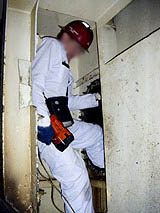Shipyard Employment eTool
General Working Conditions >> Illumination
Adequate illumination is required in walkways, work areas, and access to provide a safe work environment. [29 CFR 1915.82(a)] Permanent, temporary, and emergency lighting must be provided as required. The components of the lighting must be safe for the location in which it is installed.

Potential Hazards
Inadequate or poor-quality lighting systems can create:
- Slips, trips, and falls
- Electric shocks and burns
- Inability to exit the space
Requirements and Example Solutions
-
Temporary lights must have guards or be recessed to prevent accidental contact with the bulb. [29 CFR 1915.82(b)(1)]

-
Temporary lights must: [29 CFR 1915.82(b)(2)]

- Be equipped with heavy duty electric cords.
- Not be suspended by their electric cords.
- Have splices equal to the insulation of the cable.
- Cords must be protected from damage. [29 CFR 1915.82(b)(3)]
- Exposed non-current-carrying metal parts of temporary lights must be grounded. [29 CFR 1915.82(c)]
- Portable emergency lighting (e.g., flashlight, light sticks) must be provided. [29 CFR 1915.82(c)(1)]
-
Workers must not enter dark spaces without suitable portable light. [29 CFR 1915.82(c)(1)]

Additional Resources
- A11.1-1973, Practice for Industrial Lighting. ANSI Standard.

